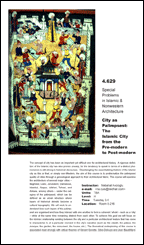4.614 Religious Architecture and Islamic Cultures
This course introduces the history of Islamic cultures through their most vibrant material signs: their religious architecture that spans fourteen centuries and three continents, Asia, Africa, and Europe. It reviews a number of representative architectural examples (mosques, madrasas, mausolea, etc.) from various periods and places and discusses their architectural, urban, and stylistic characteristics in conjunction with their historical, political, and intellectual environments. The course also analyzes the development of the sacred, commemorative, pious, and educational architecture in the Islamic world in light of a changing Islam from a reform movement in 7th-century Arabia to a global power straddling three continents in the medieval period to a world religion professed by one-sixth of humanity in the present. Films and discussions are used to elucidate the artistic/cultural varieties and historical developments of this architectural vision within both the Islamic and the larger, universal, and cross-cultural contexts.
Throughout the course, a number of critical issues will be considered: How do we define and/or qualify architecture? What is the relationship between architecture and culture? How do we study an architectural tradition that covers several regions and encompasses a variety of cultures and national and ethnic identities? And, what, if anything, is Islamic about this architecture, and how do we understand and describe it vis-à-vis the global history of architecture?
This course is offered in the fall semester. It is taught by Prof. Naby Avcioglu and meets twice a week. It is a 12 unit course, and fulfills the Humanities, Arts and Social Sciences Distribution Requirement (HASS-D) in category III (Visual and Performing Arts). The course has an open book final exam and no prerequisites.
REQUIRED TEXTS: George Michell, ed. Architecture of the Islamic World: Its History and Social Meaning, London: Thames and Hudson, 1978 [reprint 1984]. Richard Ettinghausen, Oleg Grabar, and Marilyn Jenkins-Madina. The Art and Architecture of Islam: 650-1250. New Haven and London: Yale University Press, 2001. Sheila Blair and Jonathan Bloom, The art and architecture of Islam 1250-1800. New Haven: Yale University Press, 1994.
RECOMMENDED TEXTS: Albert Hourani, A History of the Arab Peoples. Cambridge, Mass.: Belknap Press of Harvard University Press, 1991. Robert Hillenbrand, Islamic architecture: form, function and meaning. Edinburgh : Edinburgh University Press, 1994. John D. Hoag, Islamic Architecture. New York: Harry N. Abrams, 1977. |
 |
4.629 Special Problems in Islamic and Nonwestern Architecture—City as Palimpsest: The Islamic City from the Pre-modern to Post-modern
The concept of city has been an important yet difficult one for architectural history. A rigorous definition of the Islamic city has also proven uneasy, for the tendency to speak in terms of a distinct phenomenon is still strong in historical discourses. Disentangling the essentializing rhetoric of the Islamic city as this or that, or simply non-Western, the aim of this course is to problematize the palimpsest quality of cities through a genealogical approach to their architectural fabric. This course will examine the architecture of several major cities – Baghdad, Cairo, Jerusalem, Damascus, Istanbul, Aleppo, Isfahan, Tehran, and Ankara, among others – under the category of the palimpsest, which can be defined as an urban structure where layers of historical density become a cultural topography. We will seek to understand how such layers of the palimpsest are organised and how they interact with one another to form a coherent ‘whole’– such as a ‘city’ – while at the same time remaining distinct from each other. To achieve this goal we will focus on the intrinsic relationship existing between the city and a particular architectural feature that has come to characterise it, at a particular moment in the city’s narrative (such as the citadel; the palace; the mosque; the garden; the monument; the house; etc.). The theoretical underpinning of this course is associated most strongly with critical theories of Gérard Genette, Giles Deleuze and Jean Baudrillard.
REQUIRED TEXTS: Gary Bridge and Sophie Watson, eds., The Blackwell City Reader, USA: 2002 Gérard Genette, Palimpsests : Literature in the second degree, 1997. Gilles Deleuze et. all., A Thousand Plateaus: Capitalism and Schizophrenia, (University of Minnosota Press, 1987) Aldo Rossi, The Architecture of the City (MIT, 1982). Spiro Kostof, City Shaped (Boston: 1991) Preziosi, Donald, eds. The Ottoman city and its parts : urban structure and social order, 1991. Abu-Lughod, Janet L, Cairo : 1001 years of the city victorious. 1971, Princeton University Press. K.A.C. Creswell. A Short Account of Early Muslim Architecture. ed. James W. Allan. Nezar AlSayyad, Cities and caliphs : on the genesis of Arab Muslim urbanism. New York, 1991. Hourani, A., and S. Stern, The Islamic City: A Colloquium, (Oxford, 1970) Gulru Necipoglu ed., Ars Orientalis, Pre-Modern Islamic Palaces, special issue 23(1993) G. Michell, Architecture of the Islamic World: Its History and Social Meaning. London, 1978. Ira Lapidus, Middle Eastern Cities: A Symposium. Cambridge: Harvard University Press, 1969. F. E. Peters, Jerusalem and Mecca: The Typology of the Holy City in the Near East (New York University Press, 1986) Oleg Grabar, The Shape of the Holy (Harvard University Press, 1998) Heghnar Watenpaugh, The Image of an Ottoman City : Imperial Architecture and Urban Experience in Aleppo in the 16th and 17th Centuries, Brill : 2006. Elizabeth MacDougall and Richard Ettingausen, eds., The Islamic Garden (Dumbarton Oaks, l976) Sibel Bozdogan, Modernism and Nation building: Turkish Architectural Culture in the Early Republic, (Washington: 2001) |

